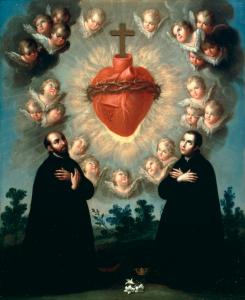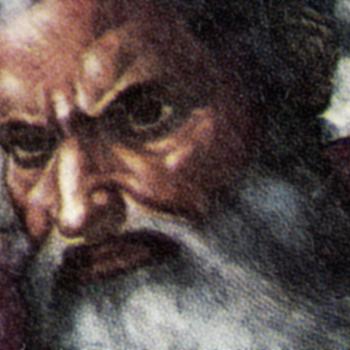
Heart of Jesus with Saint Ignatius of
Loyola and Saint Louis Gonzaga.”
The Solemnity of the Most Sacred Heart of Jesus occurs every year on the Friday after the Feast of Corpus Christi. In 2018, that means it falls on June 8.
Before I became a Catholic, I thought images and statues of the Sacred Heart were, well, a little creepy. I remember my first visit to Ireland, staying at B&Bs which allowed me an intimate glimpse into the homes of ordinary Irish folk. At that time the overwelming majority of the Irish — well, at least the women — were still devout and practicing Catholics, so many homes featured framed photographs of the pope, or statues of the blessed virgin, or prints of the Sacred Heart of Jesus flanked by the Immaculate Heart of Mary.
Having been raised Protestant, I never could make sense of why the images always depicted Jesus’s and Mary’s hearts right in front of their chests — and then how the hearts were accessorized, a crown of thorns circling Christ’s heart, a ringlet of roses surrounding his mother’s.
It wasn’t until after I became a Catholic that I discovered that the “Two Hearts” as they are informally known are the object of devotion, at least for some Catholics. It makes a certain kind of sense — we associate the heart with love, do we not? What would Valentine’s Day be without heart-shaped imagery (and boxes of chocolate)? Isn’t it thrilling to hold your spouse — or a newborn baby — close enough that you can feel their heartbeat? So for many people, the heart means love, and therefore we venerate the heart as a way of expressing our love for anyone we cherish.
A Long-Standing Devotion
In the history of Christian spirituality, the idea that Christ’s heart is particularly sacred — and therefore supremely worthy of our reverence — goes back to the earliest centuries of the church. Early Christian writers like St. Irenaeus or St. Cyprian expressed love for the heart of Christ in their writings. In the middle ages, great mystics like Saint Bernard of Clairvaux, Saint Bonaventure and Saint Gertrude the Great all wrote of their devotion to the Sacred Heart.
The fourteenth century mystic Julian of Norwich received a vision of the Sacred Heart — not pierced by the crown of thorns, but “riven in two” by the spear that was thrust into Jesus’s side — which she described as “a beautiful and delightful place” where all those who love Christ may rest “in peace and in love.” As she put it in her Revelations of Divine Love:
Then with a glad expression our Lord looked into his side and gazed, rejoicing; and with his dear gaze he led his creature’s understanding through the same wound into his side within… And with the precious vision he showed his blessed heart quite riven in two.
Yet devotion to the Sacred Heart has especially become associated with a seventeenth century saint and visionary, Margaret Mary Alacoque, who insisted that Jesus came to her and encouraged her in her devotion to the Sacred Heart. At first she received no support for her claim of receiving visions, but she soon caught the attention of her confessor, a Jesuit priest named Claude de la Colombière. Thanks to de la Colombière, the Jesuits became committed to devotion to the Sacred Heart, and about 75 years after St Margaret Mary’s death, the devotion finally received papal approval and became part of the mainstream devotional life of the church.
With the second Vatican Council in the 1960s, many Catholic devotional practices began to fall out of favor, including devotion to the Sacred Heart — although in the years since the council, many conservative and traditionalist Catholics hold on to these very devotions, probably for no other reason than they symbolize a distinctively Catholic expression of faith.

The Sacred Heart Today
Is there a place for devotion to the Sacred Heart in our time? Is it just a vestigial sign of baroque piety, largely theologically irrelevant in our time?
At least one Jesuit priest in our day is following in the footsteps of Claude de la Colombière. Fr. James Kubicki, SJ, wrote a book called A Heart on Fire: Rediscovering Devotion to the Sacred Heart of Jesus. Fr. Kubicki wants to see a revival of devotion to the Sacred Heart, but to bring the devotion into line with the best theology of our time — in other words, instead of stressing a legalistic approach to Christ suffering-for-our-sins, devotion to the Sacred Heart makes the most sense when it is grounded in love: beginning with God’s love for us.
Fr. Kubicki writes,
Sacred Heart devotion isn’t our devotion. It’s God’s. It’s God’s devotion to us. Our devotion is only a response to God’s devoted love, because God loved us first.
To be devoted to the Sacred Heart, therefore, means ultimately to be devoted to Love.
So if melodramatic art or devotional pamphlets that seem to overly obsessed with sin aren’t your cup of theological tea, maybe there is still a way to embrace Christ’s sacred heart as part of your spiritual practice. Which leads me to what I think is the ultimate “secret” of the Sacred Heart.
Love, you see, is always relational. Love requires both a lover and a beloved. Indeed, some people see the Holy Trinity as the ultimate icon of love: God is the lover, Christ the beloved, and the Holy Spirit is the love that continually flows between and beyond them.
So for us to be devoted to the Sacred Heart of Christ, we need to acknowledge that Christ’s heart longs for our hearts. What makes the Sacred Heart so beautiful is the fact that it eternally loves for our hearts, like any lover longs for their beloved.
In her song “Mandinka”, Sinead O’Connor sings “Soon I can give you my heart.” Isn’t that what love is ultimately about? If I love you, I will give you my heart. The reason why the Sacred Heart is such a beautiful object of devotion is because Christ gives us his heart. All he asks in return, is that we give him ours.
That’s a precious gift, granted. The heart is the engine of life. And the heart is also the fountain from which all of our capacity to love flows. Indeed, whatever love you and I can share with others originally comes from God — as Saint Paul wrote, “the love of God has been poured out into our hearts through the Holy Spirit that has been given to us” (Romans 5:5) — so our hearts are the portals through which God loves the world — through the gift of the Holy Spirit.
It’s like the Holy Trinity all over again. Only this time, it is the Christ (and the Father with whom Christ is one) who is the lover, and we — you and I, and all who choose to ground our lives in love — are the beloved. And once again, the Holy Spirit is the love that flows between and beyond us. And it is our hearts through which the love of the Spirit flows.
Happy feast of the Sacred Heart, my friends. May God’s love flow abundantly to you and through you, and may you joyfully and lavishly share that love with others.
Enjoy reading this blog?
Click here to become a patron.













